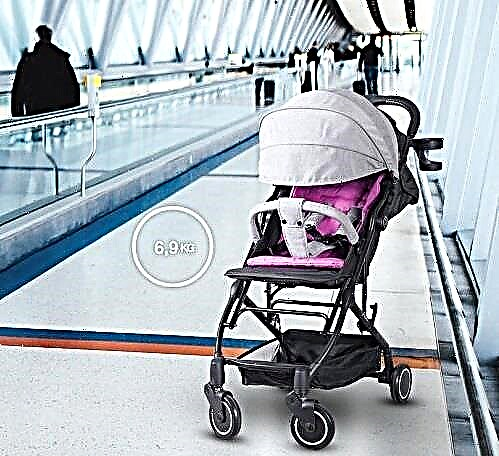Banana can be safely introduced into the diet of babies up to one year old. A very tasty and nutritious fruit will satisfy hunger, saturate the body with the necessary vitamins, minerals, substances necessary for proper development.

Baby eating with a spoon
The benefits of bananas for a child
For the child's body, bananas have the following benefits:
- Promotes muscle growth;
- Regulate chemical processes in the blood;
- Support the proper functioning of the heart and blood vessels;
- Normalize kidney function;
- Supports immunity;
- They have a positive effect on the nervous system, help fight stress, anxiety and anxiety.
- Adjust hormonal levels;
- Accelerate metabolic processes;
- Ensure the normal development and functioning of the brain;
- Charge the child's body with a lot of energy;
- Contains soluble fiber, which promotes proper digestion and fights constipation;
- Due to the iron content, they maintain a good level of hemoglobin.
Important! Unripe bananas very often have the opposite effect and cause constipation.

Healthy fruit
Nutritional value
100 g of banana pulp contains:
- Proteins - 1.5 g;
- Fat - 0.5 g;
- Carbohydrates - 21 g;
- Fiber (dietary fiber) -1.7 g;
- Organic acids - 0.4 g;
- Water - 74 g;
- Unsaturated fatty acids - 0.2 g;
- Mono, - and disaccharides - 19 g;
- Starch –2 g;
- Ash - 0.9 g;
- Saturated fatty acids - 0.2 g
The calorie content of the pulp of a ripe banana is 96 kcal per 100 g.
Banana pulp contains a group of B vitamins (B1, B2, B3, B5, B6, B9), ascorbic acid, choline, vitamins E, K, PP and beta-carotene, as well as micro- and macronutrients vital for the child's body, among of which potassium and magnesium are in the lead.
Bananas also contain other minerals: Iron, Zinc, Manganese, Selenium, Fluorine. The amino acids contained in banana support all the vital functions of the growing body.

Nutritious tropical fruit for kids
How to get good bananas
When buying, you should pay attention to the following points:
- Fruit shape. The banana should not be ribbed. A quality fruit has a streamlined shape.
- Peel. A good banana has a matte and smooth skin.
- Colour. Ripe exotic fruit has a bright yellow hue. If the color of the fruit is a little greenish, then such a banana is simply not ripe. You can buy it and put it in a dry, warm place. After a few days, the peel will turn yellow.

Ripeness of tropical fruit
When to add banana to complementary foods
The opinions of pediatricians about how many months from how many months a banana can be given to a child as complementary foods differ greatly. Some say that it is best not to introduce a tropical fruit until eight months. Others believe that nothing bad will happen if the baby tries the sweet fruit complementary foods as early as 5 or 6 months. Experts agree on one point - it's not worth starting feeding with a banana. As the first complementary food, the baby should be offered vegetables, otherwise, after a very sweet fruit, he will refuse to eat foods with a less pronounced taste.
Note! Parents need to know when to introduce a banana into complementary foods and at what time of day. It would not be the best solution for them to feed the child in the evening - this can lead to difficulties with falling asleep and discomfort in a small tummy.
In what form can a banana be given
When can a banana be given to a baby and in what form? From five months, the fruit can be offered to the crumbs in a blended form, adding breast milk or a mixture. This is necessary so that the taste of the new product is familiar to the child. Also, by diluting the thick pulp with liquid milk, you can get such a puree consistency that will be better absorbed by the digestive system of the crumbs.
For the first time, you can prepare a fruit for use by a baby as follows:
- Peel the fruit and remove hard veins.
- Then boil for 6-7 minutes in a water bath or in a double boiler.
- Then remove the pulp, chop it in mashed potatoes, add a small amount of milk or mixture.
Subsequent times, this fruit can be offered to babies in this form:
- Put the fruit in a nibbler and serve as such to the baby. The safest way that allows you to simultaneously massage the gums of the crumbs;
- If you want to quickly make mashed potatoes, you can scrape the pulp with a spoon from the whole fruit;
- You can get mashed potatoes from fruit in several ways: grind the pulp with a fork, pass through a chopper, grate on a fine grater. You will get a liquid consistency if you add mixture or breast milk to the banana puree.
Starting from 5-7 months of age, the baby can be given a banana in the form of a liquid puree. From 8-10 months, the liquid consistency can already be replaced with a thicker one. By one year and older children, a banana can be given in small pieces or as a whole, but only if the first teeth have grown.

Fruit bunch
Banana feeding rates by month
A banana complementary feeding to a breastfed baby is replaced by one feeding with breast milk or a mixture - for babies on artificial feeding. When introducing a banana into a baby's diet for the first time, you need to start with very small portions.
Banana puree is recommended to be added to complementary foods in the same way as all other products: first, the child is given a quarter of a teaspoon to taste, then half a teaspoon, and so on. Complementary foods must be introduced for 4-7 days.
The main rules for meeting a kid with a tropical fruit are as follows:
- Banana should be introduced into complementary foods very carefully. The first time you need to do this in the morning, so that you can track the body's reaction to a new food. Depending on the age of the baby, give him a certain amount of fruit;
- For the first time, it is given to a crumb on the tip of a teaspoon;
- The mass must be homogeneous;
- Puree can be additionally diluted with breast milk or formula;
- The product must be fresh and ripe, but not overripe;
- After the baby has tasted a banana, after a while, you need to evaluate his reaction to the product, pay attention to whether any allergic manifestations have appeared.
How often to give
Until a year, the consumption rate of bananas is no more than 2-3 times a week. From 1.5 years old, you can give the fruit five times a week. From the age of three, the baby can feast on tropical fruit every day.
Number
At what age can a child be given a banana and how much? At 5-6 months, the baby can be offered no more than 3 tablespoons of banana pulp at a time. Chop the pulp of the fruit and give the baby a quarter of a teaspoon. In this case, you need to observe the reaction of a small organism to new food. If there is no constipation or allergies, then you can continue to introduce the fruit, increasing the portion by 0.5 teaspoon every day.
The norm for an eight-month-old baby is half the fetus (approximately 80 g). A child can eat one small banana (90-100 g) per year. By the age of 1.5 years, the baby can be given one medium-sized banana (approximately 120-150 g).
From 3 years old, the baby can overpower one large banana (about 200 g) per day, feed it up to five times a week. From the age of six, you can feed your baby two bananas a day (about 300-350 g).
What can be combined with
Like any other fruit, banana can be added as much as you like to oatmeal or rice porridge, mixed with baby kefir, yogurt without fillers, cottage cheese and ground cookies. Also, the fruit goes well with various berries and fruits, the main thing is that the child likes the taste. Komarovsky states that oatmeal with sweet fruit is the best complementary food.
Possible problems with complementary feeding
Despite all the positive properties, a banana can also be harmful to the child's body:
- With obesity. Do not give too much fruit to overweight newborns. Due to the high content of fructose and sucrose, a quick set of extra pounds will be stimulated.
- Allergic reaction. Banana is considered to be hypoallergenic. But cases of allergy are still sometimes encountered. Manufacturers often process tropical fruits with chemicals for longer storage. They can cause rashes on the baby's skin.
- Stool problems. If at the time of the introduction of the fruit into complementary foods the baby has problems with the digestive system (constipation, increased gas production, diarrhea), it is better not to rush to acquaint the baby with this fruit, so as not to aggravate the condition.
- For children who have inherited diabetes from their parents, or have increased blood clotting, it is absolutely contraindicated to eat sweet fruits.
Note! If a negative reaction to a product appears, it is worthwhile to exclude it from the menu for a while and consult a doctor for advice.
Signs of allergies
Banana allergies in children are rare. As a rule, it does not arise on the fruit itself, but on certain chemicals with which producers process fruits to extend the shelf life.
Allergy manifests itself in the form of the following symptoms:
- Redness appears on the skin, a rash that is very itchy. Most often, the face, arms, legs and abdomen are affected;
- There is nausea, digestive tract upset (diarrhea, constipation);
- The child suffers from abdominal pain and severe gas formation;
- A runny nose appears, the baby sneezes, his tears flow.
Banana is a very tasty and healthy fruit for a little crumb. Parents should know from how many months a banana can be given to an infant, adhere to certain age norms for introduction into complementary foods, and also not exceed the dosage.



